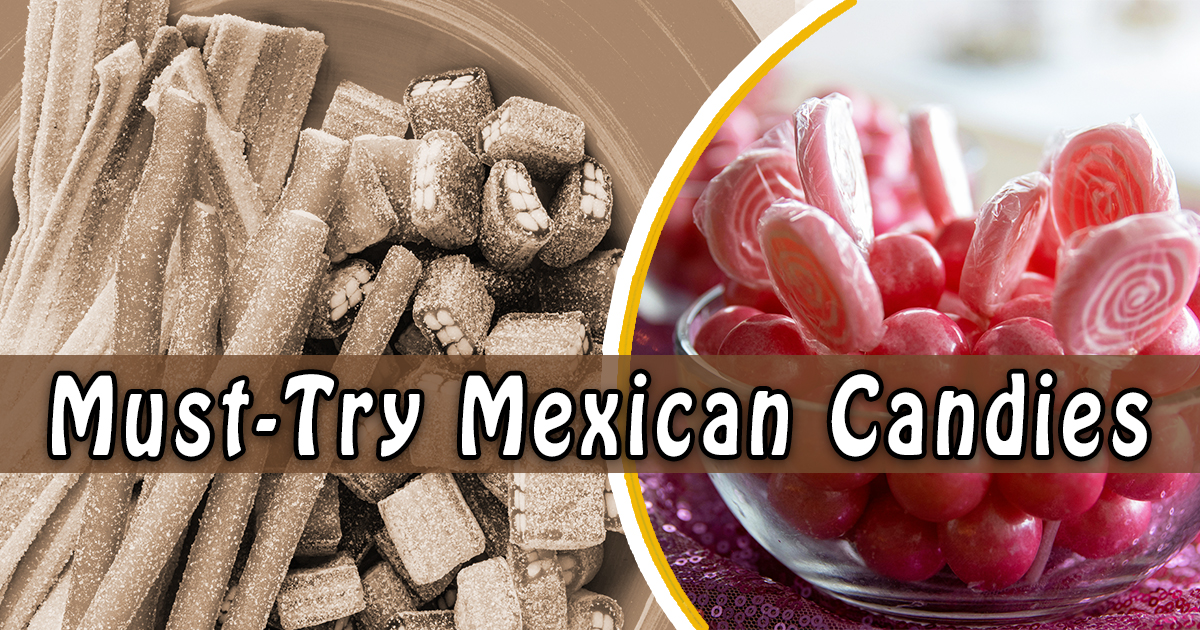Mexican candies have a rich and storied history that dates back to pre-Hispanic times. The indigenous people of Mexico were already using local ingredients like tamarind, cacao, and chili peppers to create flavorful snacks. When the Spanish arrived, they brought sugar and new techniques that fused with local traditions, creating a vast array of Mexican sweets. Today, Mexican candies blend both indigenous and European influences, resulting in one of the most unique candy cultures in the world.
2. Top 10 Best Mexican Candies You Should Try Today
Here’s a list of 10 best Mexican candy that offer something for every type of candy lover. From sweet to sour, to spicy and savory, these candies will take you on a flavor journey like no other.
- Pulparindo – Made with real tamarind pulp, this candy blends sweet, sour, and spicy in every bite.
- Mazapan – A crumbly, peanut-based candy that melts in your mouth.
- De La Rosa Marzipan – Similar to Mazapan but with a nutty, almond flavor.
- Pelon Pelo Rico – A tamarind-based candy that you squeeze out of a tube, offering a fun and interactive experience.
- Vero Mango – A lollipop coated in chili powder that balances sweetness with a spicy kick.
- Lucas Muecas – A sweet and tangy powder candy that can be sprinkled on fruit or eaten directly.
- Cucharita Rica – Spoon-shaped candy that’s a sticky, tamarind-flavored treat.
- Obleas – Thin wafers filled with sweet milk, a classic Mexican dessert in candy form.
- Rellerindos – Hard candy with a spicy tamarind filling that offers a burst of flavor.
- Las Sevillanas Cajeta Lollipops – Made from goat’s milk, these lollipops are creamy, sweet, and rich.
3. Why Mexican Spicy Candies Are a Unique Flavor Experience
What makes Mexican candy stand out from others around the world is their use of spices—particularly chili. Unlike the typical sugary sweetness you find in most candies, Mexican spicy candies blend sweet, sour, and spicy flavors to create an unforgettable taste experience. Candies like Pulparindo and Vero Mango may shock your palate at first, but once you get used to the combination of tamarind, sugar, and chili powder, you’ll find yourself reaching for more.
4. How Mexican Candies Blend Sweet, Sour, and Spicy in Every Bite
One of the hallmarks of Mexican candy is the way it blends multiple flavor profiles—sweet, sour, and spicy—into one treat. This flavor fusion is primarily achieved using tamarind, a sour fruit commonly used in Mexican sweets. Tamarind paste forms the base for many popular candies, like Pelon Pelo Rico and Pulparindo. The addition of chili powder to these candies gives them a spicy kick, while sugar balances everything out. This intricate balance of flavors is what makes Mexican candy a delightful experience for those who enjoy a bit of everything.
5. The Influence of Mexican Candies on Global Snack Culture
Mexican candies are no longer limited to Mexico; they have become popular worldwide, especially in the United States, where you can easily find a variety of Mexican snacks. Many international snack companies have even drawn inspiration from traditional Mexican candies, creating their versions of tamarind-flavored treats and spicy lollipops. This global influence showcases how Mexican candy continue to shape snack culture beyond their borders.
6. Exploring the Different Types of Mexican Candies: From Tamarind to Chili
Mexican candies come in all shapes and sizes, with each one offering a unique flavor profile. Below are some common types of Mexican candies you should know about:
- Tamarind-based candies: Tamarind is a key ingredient in many Mexican treats, known for its sour and tangy taste. Examples include Pulparindo and Pelon Pelo Rico.
- Chili-coated candies: Many Mexican candies, especially lollipops like Vero Mango, are coated in chili powder, offering a spicy twist.
- Milk-based candies: Sweets like Las Sevillanas Cajeta Lollipops use goat’s milk or cow’s milk to create a creamy, sweet treat.
- Fruit-based candies: In addition to tamarind, other fruits like mango, guava, and pineapple are used in candies like Lucas Muecas.
7. Are Mexican Candies Healthy? Healthier Alternatives to Enjoy
While Mexican candies are certainly delicious, they are often high in sugar, and many contain chili powder, which may not suit everyone’s digestive system. However, if you’re looking for a healthier option, you can try candies made with natural sweeteners or organic ingredients. For instance, some brands now offer organic tamarind candies that provide the same sour-sweet flavor without the added preservatives and artificial colors.
8. Where to Buy Authentic Mexican Candies Online
Thanks to their growing popularity, it’s now easier than ever to buy Mexican candies online. Websites like MexGrocer.com, Amazon, and La Tiendita carry a wide variety of traditional Mexican candies, from Pulparindo to De La Rosa Mazapan. You can even find specialty shops that import hard-to-find treats directly from Mexico, ensuring you get an authentic candy experience.
9. Famous Mexican Candies You Can Find Internationally
Several Mexican candies have become household names across the globe. Whether you’re visiting a Mexican grocery store or shopping online, you can easily find these internationally recognized treats:
- Lucas Muecas
- Vero Mango
- De La Rosa Mazapan
- Pulparindo
These candies not only bring the flavors of Mexico to the world but also introduce people to the country’s rich and diverse culinary traditions.
The Cultural Significance of Mexican Candies
Mexican candies are more than just sweet treats; they hold a deep cultural significance, especially during festivals and celebrations. For instance, Día de los Muertos (Day of the Dead) often features calaveras de azúcar (sugar skulls), which are colorful, sweet candy skulls placed on altars to honor deceased loved ones. Candies like these are deeply tied to Mexican traditions, blending food with cultural expression.
Additionally, candies such as Alegrías, made from amaranth seeds, date back to pre-Hispanic times and are still enjoyed today as a snack that links the present with the past. This connection between candy and culture makes Mexican candies unique, as they often serve as a way to preserve heritage and celebrate Mexican identity.
Mexican Candy in Modern Cuisine
With the growing popularity of Mexican flavors worldwide, Mexican candies are making their way into modern cuisine and desserts. Chefs and food enthusiasts alike are incorporating candies like Pelon Pelo Rico and Tamarindo candies into creative desserts such as spicy popsicles or candied fruit tarts. These candies bring a delightful fusion of spicy, sour, and sweet flavors that are becoming popular beyond traditional snacks.
Healthier Alternatives in Mexican Candies
While many traditional Mexican candies are known for their sweetness and use of sugar, there’s a growing trend toward healthier alternatives. Modern versions of classic treats like Alegrías (made from amaranth seeds) are being produced with less sugar and natural sweeteners. These healthier options offer the same great taste but cater to more health-conscious consumers.
In addition, candies like Tamarind-based treats are naturally rich in fiber and antioxidants, making them a guilt-free indulgence for those looking for a balance between flavor and nutrition. Some candy producers are also focusing on organic ingredients and reducing artificial coloring, which appeals to a more modern, health-aware audience.
The Future of Mexican Candies
As demand for exotic and flavorful sweets continues to grow globally, Mexican candies are poised to become even more popular. Their unique combination of spicy, sour, and sweet flavors appeals to adventurous palates, and with innovation in healthier versions, these candies will continue to charm future generations.
For a deeper dive into traditional sweets, visit our detailed guide on Mexican candy and explore a variety of authentic treats.
Conclusion: Mexican Candies – A Sweet and Spicy Adventure You Can’t Miss
If you’re looking to spice up your candy choices, Mexican candies are the way to go. With their unique blend of sweet, sour, and spicy flavors, they offer an exciting departure from the typical sugary treats you might be used to. From tamarind-based snacks to chili-coated lollipops, there’s a Mexican candy for everyone. Whether you’re a fan of traditional sweets or are looking for a new flavor adventure, these candies will not disappoint.
FAQs about Mexican Candies
1. What is the most popular Mexican candy?
The most popular Mexican candy is arguably Pulparindo, a tamarind-based treat that offers a unique combination of sweet, sour, and spicy flavors. It’s beloved not only in Mexico but also internationally.
2. Why do Mexican candies have chili in them?
Many Mexican candies incorporate chili powder because Mexican cuisine, in general, celebrates the combination of sweet, sour, and spicy flavors. Adding chili provides a kick that balances the sweetness and enhances the overall taste experience.
3. Are Mexican candies gluten-free?
Some Mexican candies are naturally gluten-free, like Pulparindo and Mazapan. However, always check the label for ingredients if you have dietary restrictions, as some candies may include additives that contain gluten.
4. Can I buy Mexican candies outside of Mexico?
Yes, you can find Mexican candies at many online retailers, including Amazon.com, and MexGrocer.com, and specialty shops that import candies from Mexico. Some local grocery stores, especially those with a Hispanic section, may also carry these candies.
5. Are Mexican candies safe for children?
While most Mexican candies are safe for children, some contain chili powder, which may be too spicy for younger kids. It’s a good idea to start with milder candies like Mazapan or De La Rosa Marzipan before introducing spicier options.

Joseph Bush is a seasoned writer and researcher with over 7 years of experience covering a wide range of general topics, from lifestyle and technology to business and current events. He is dedicated to producing fact-checked, reader-friendly content that informs, engages, and empowers readers.
Throughout his career, Joseph has followed strict editorial guidelines, relied on reputable sources, and ensured every article meets the highest standards of accuracy and clarity. His expertise spans multiple fields, allowing him to explain complex topics in a way that’s easy to understand.
Passionate about continuous learning, Joseph stays updated on industry trends and best practices to deliver trustworthy, well-rounded insights. Readers can rely on his work for its credibility, depth, and real-world relevance.




